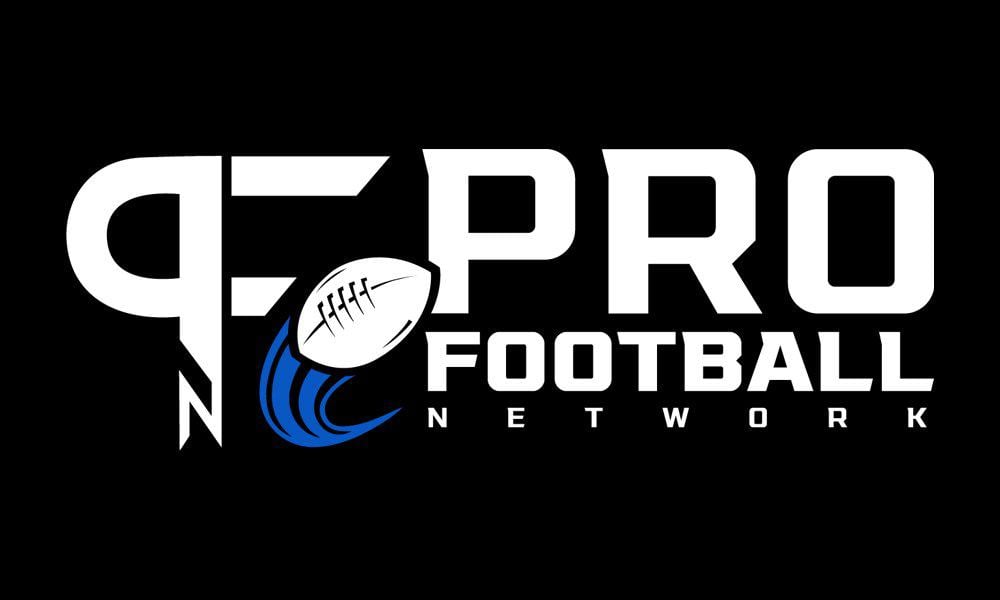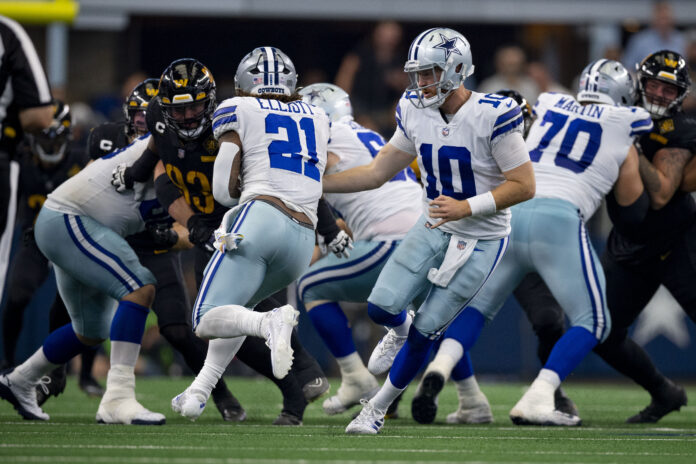Football is a cat-and-mouse game, and pony personnel (two running backs on the field together) always get air time during the offseason. Offenses innovate, and defenses react to that innovation. Rules began changing in the secondary, so offenses got smaller and were based more on speed. The passing attack overwhelmed the run game, and defenses followed suit by getting smaller and fielding linebackers weighing 20 fewer pounds.
Sean McVay is a special breed of innovator. The head coach of the Los Angeles Rams popularized pre-snap motion in the run game to generate doubt in the minds of linebackers. He began using receivers like Robert Woods and Cooper Kupp as sift blockers and using them in short motion to crack edge defenders, essentially making them move tight ends.
McVay was also quick to adjust. When he saw a non-existent run game to the start of the 2022 season, he moved wide receiver Ben Skowronek into the backfield to play fullback. He isn’t just playing fullback, though. He’s still being used as a traditional receiver more often, but the package is present with him in the backfield. That wasn’t an offseason plan.
So if McVay can adjust on the fly, why can’t the Green Bay Packers and Dallas Cowboys install a comprehensive package utilizing pony personnel, given each team’s seemingly underwhelming receiving corps?
What Is the Pony Personnel Package?
Pony personnel is not the normal two-back personnel we’re used to seeing in San Francisco with Kyle Jusczyk (although Kyle Shanahan uses him uniquely compared to most fullbacks).
Pony personnel is a two-back set with two running backs. They don’t have to both be in the backfield, as it’s not a formation, but the players are on the field.
How the Packers and Cowboys Use Pony Personnel
Aaron Jones and AJ Dillon are a dynamic duo in the backfield for the Packers. Ezekiel Elliott and Tony Pollard are much the same for the Cowboys. Each franchise has a “thunder and lightning” factor, although the primary roles are flipped. Jones is the lightning for Green Bay and is the primary back, while Zeke is the thunder and the primary back for Dallas.
There was a lot made of pony personnel being a thing for Green Bay this season. Justis Mosqueda wrote about the Packers’ problems through three games using this package. Green Bay didn’t lack frequency. Mosqueda noted that they’d used it 28 times in three games.
Of those 28 snaps, 22 were some fashion of split-back gun. By my count, Green Bay showed trotted both workhorses out 12 times, making their average 10 plays in pony personnel per game.
All 12 snaps were from split-back gun. Most of those snaps were read-option looks with a swing screen by the back opposite. Only two of the 12 snaps were straight dropbacks, and they were both in the first quarter of the game.
The most confusing snap of the game happened in overtime. The Packers went to split-back gun, but they ran it out of 12 personnel instead of 21.
Is the 240-pound running back with quads the size of my midsection unable to come across the formation and get in the way of an edge rusher?
And that’s the issue with two-back sets. They’re painstakingly predictable, particularly for the Packers. While most passing attacks aren’t based out of two-back sets anymore, what is keeping the Packers from putting Jones in the slot or out wide?
I’m a writer, and even I could run a hitch from outside the numbers or a quick out from the slot. Jones could do it in his sleep.
And Then There’s Kellen Moore’s Cowboys…
Talk about misuse of company funds! During mini camps and training camp, we heard from sources far and wide that Tony Pollard was working with receivers, running routes, and catching passes. Pollard has lined up in either the slot or wide 26 times in the first four weeks. He’s caught seven passes in 2022 for 71 yards. His aDOT is 0.
He’s not catching digs, slants, outs, posts, comebacks, or fades.
The Cowboys use their version of pony personnel even more sparingly. It’s more of a situational look for them than a part of the standard down-to-down game plan. They’ll line up in a strong I formation with Elliott at fullback and run a fullback dive with him in short-yardage situations.
The other primary use is getting the ball into Pollard’s hands on the edge using jet and orbit motions. He’s not lining up in the slot or out wide running routes.
The Cowboys have shown Pollard and Elliott on the field together 19 times in four weeks.
Taking Inspiration From… the Jets?
You read that right, sports fan! To find some variety in pony personnel, we must visit the Meadowlands and, more specifically, the brother of the Packers’ head coach. Mike LaFleur is the offensive coordinator of the Jets. Robert Saleh is a defensive head coach, so LaFleur is the architect of the offense.
Drafting Breece Hall in the second round of the NFL Draft was a peculiar decision by a team that’s not ready to compete. It already had one talented back in Michael Carter, who is entering just his second season.
The way LaFleur deployed the two backs when both were on the field piqued my interest in writing this piece. The Jets only ran six plays with pony personnel against the Steelers. But it was the variety in deployment that was interesting.
Interestingly enough, there was no 20 personnel involved. With Garrett Wilson, Elijah Moore, and Corey Davis, they have a dangerous quintet of talents to get the ball to. Instead, they aligned out of 22 personnel twice and 21 personnel four times.
Three of the six snaps were two-back gun formations. Twice they ran power with a guard ad Carter leading, with the tight end sifting underneath as a shovel option.
Somewhere Andy Reid was chowing down on some delicious Kansas City BBQ with a tear of admiration rolling down his cheek. They picked up a first down on both runs, going for nine yards and 16 yards, respectively. LaFleur called it to opposite sides.
The long mesh and tight end shovel option makes this work. That action froze the linebackers enough both times to let Hall escape to the edge. Those two run plays were the only two similar looks the Jets gave in this grouping.
Elliott is a fantastic blocker, and Dalton Schultz is a weapon after the catch. Using Elliott as the lead blocker and Shultz as the sifter seems like a design Moore, who often borrows concepts, should implement.
Unfortunately, the play fake was too good for the sideline cameraman, who zoomed in on the tackled Carter. If Wilson settles here, he most likely hits Hall streaking down the sideline after running a flat route that he bent vertically. The running back had a step on the cornerback.
The Jets even went empty with both of them on the field. In fact, they lined up in a 4×1 set with Carter as a wing and Hall on the outside. They ran a spacing concept, and Wilson got caught up on the backside read that was covered more comprehensively than Adam Levine’s extramarital activities.
The other two looks were zone runs out of different personnel groupings and formations. In those six plays, the Jets showed more variety than the Packers did on twelve snaps in Week 4.
Simple Things Can Break Trends
It wouldn’t take much to keep defenses honest against the Packers and Cowboys pony personnel packages. The Indianapolis Colts have found ways to get Nyheim Hines integrated into the passing attack for years now.
While his overall aDOT pales in comparison to a traditional receiver because backfield targets remain his primary function, the Colts change things up enough to keep the secondary honest when he’s on the field at the same time as Jonathan Taylor.
It’s not rocket science. Any running back is asked to run a “Texas” route at one point or another. Why couldn’t they run a one or three-step slant, a vertical route, a hitch/curl, a square in, or a square out every once in a while?
Realistically, Jones and Pollard wouldn’t even have to be outstanding in their efforts in the slot or out wide. They’d only need to be enough of a threat to hold defensive backs honest in coverage. However, with Pollard’s collegiate background in the position, that shouldn’t be an issue.
The Packers would benefit most from this. Currently, defenses are keying on their read option swing RPO. Green Bay must also start either running more straight dropback and play-action looks from their split-back formation.
Additionally, the Cowboys should take a page from Shanahan’s playbook because Zeke is such a dominant blocker. He could align as a traditional fullback and be used as a vertical threat in play action the way Shanahan uses Jusczyk.
But it takes chutzpah to buck trends and go in a different direction than the rest of the league. Bill Belichick has done it for his entire Patriots tenure with the most success of any coach in NFL history. Meanwhile, McVay is doing the same, and he has been to two Super Bowls since 2018 and has one ring to show for it.
The numbers are out there for teams. Pony personnel garnered a negative EPA a season ago. But if a team with two talented backs committed to it and gave defenses more than just a few questions to answer, they might just find a market inefficiency.
After all, fortune favors the bold.

